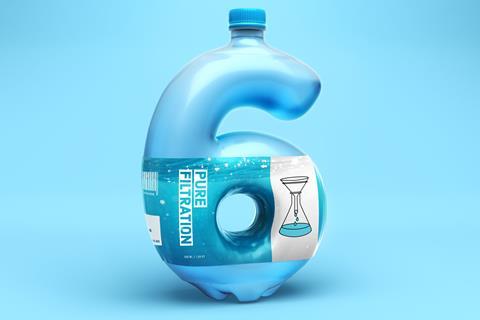Use these tips and activities to link UN sustainable development goal 6 to separation techniques, potable water and more


This article is part of the Sustainability in chemistry series, developed to support the integration of the UN’s Sustainable development goals into your teaching of chemistry. It supports Goal 6: ensure availability and sustainable management of water and sanitation for all.
Water features in chemistry teaching across the secondary age range and Goal 6, ensure availability and sustainable management of water and sanitation for all, aligns with many water chemistry topics. You can easily fit the goal into your teaching of separation techniques, sustainability of resources, potable water and the treatment of wastewater.
Many students don’t give water a second thought. They turn on a tap and water gushes out. In Northern Europe, where rainfall is frequent and lakes and rivers are abundant, water is an underappreciated resource. Our students may not grasp the importance of water as a resource and may take water science for granted. Introducing a discussion of Goal 6 when you teach a water topic shows students just how relevant water chemistry is to the human population.
Download this
Class practical, for age ranges 14–16 and 16–18
A class practical using a microbiology experiment to investigate the antibacterial properties of the halogens. Use it with your 14–16 students to develop water purification practical work; add the extension questions to use the investigation for the 16–18 age group.
Download the student worksheet as MS Word or pdf and the teacher notes (including answers) as MS Word or pdf.
Download the worksheet, teacher and technician notes from the Education in Chemistry website: rsc.li/xxxxxxx
Put it in context
It’s important to show students that chemistry has a key role to play in all aspects of Goal 6: ensuring safe, sustainable and affordable drinking water for all requires management of natural resources and water-related ecosystems, development of water technologies and management of wastewater – all of which involve chemists.
Achieving Goal 6 in the desired timeframe isn’t a given. This is an essential point to share with your students. The UN considers this goal to be badly off track and its latest report makes for depressing reading. In 2017, 40% of the world’s population didn’t have access to handwashing facilities with soap – a statistic made all the more sobering by the coronavirus pandemic.
More resources
- Create context with scientific research using this starter slide with questions: How ancient Maya peoples made potable water.
- Link to careers with this video profile of a laboratory analyst and higher degree apprentice who tests drinking water for 15 million people.
- Develop literacy and trigger discussion with these differentiated DARTs (Directed Activities Related to Text) based on waste water treatment.
- Precious water offers lots more classroom resources with links to off-grid water treatment technologies.
Water is a vital resource, needed for all aspects of life. Students will be familiar with the obvious uses – drinking, cooking and washing – but you might need to point out other uses, such as manufacturing. Much of our water consumption is hidden in these other uses. For example, it takes around 50 litres of water to produce 1 kg of plastic. So it takes twice as much water to produce a plastic water bottle as the amount of water contained in the bottle.
The future impact of insecure water supplies in other countries could be huge. Water could become a source of conflict between countries and it is already a push factor for migration. As citizens of high-income countries, we cannot ignore this goal because we feel it doesn’t directly affect us.
Put it into practice
You can use Goal 6 to add context and relevance to your teaching of potable water and separation techniques. Before you begin teaching the pure chemistry, introduce the topic’s significance with the infographics from the UN’s useful site dedicated to the SDGs. Adding slides to an existing presentation is a simple way to integrate this into your teaching. For example, the Goal 6 infographic would work well as the title slide for a presentation on drinking water production or desalination for the 14–16 age range.
Working with data is a key skill across all stages and qualifications in chemistry. The UN Water SDG 6 data portal is an excellent source of data on progress in this area and is easily navigable. Use the data to construct questions for students to practise writing longer responses involving comparisons. You can also use the portal to introduce the impact of missing data on our understanding of the world.
Cross-curricular opportunities
The Eco Schools programme offers a way to engage with students at the wider school level. Water is one of the ten topics in the programme and encourages student teams to develop initiatives for saving water at school. The programme also looks at global citizenship, which would help students to connect local action with international impact.
Practical activities can help students make links between real-life contexts like Goal 6 and pure chemistry. A great starting point is the classic activity of getting clean water from a contaminated water source, suitable for the 14–16 age group. You can extend this activity with a discussion on the presence of microorganisms which would not be removed by filtration. The download accompanying this article offers a further investigation to explore the antibacterial nature of the halogens.
Help students connect their thinking about water with their local context. Local water board websites can be excellent sources of information. For example, Thames Water is the UK’s largest water and wastewater services company, supplying 2.6 billion litres of drinking water every day and its education website offers a wide range of learning materials for all stages of education. You can send students to this reliable website to research a water topic or use the well-explained home experiments to add variety to homework.
Check out the rest of the Sustainability in chemistry series.














No comments yet